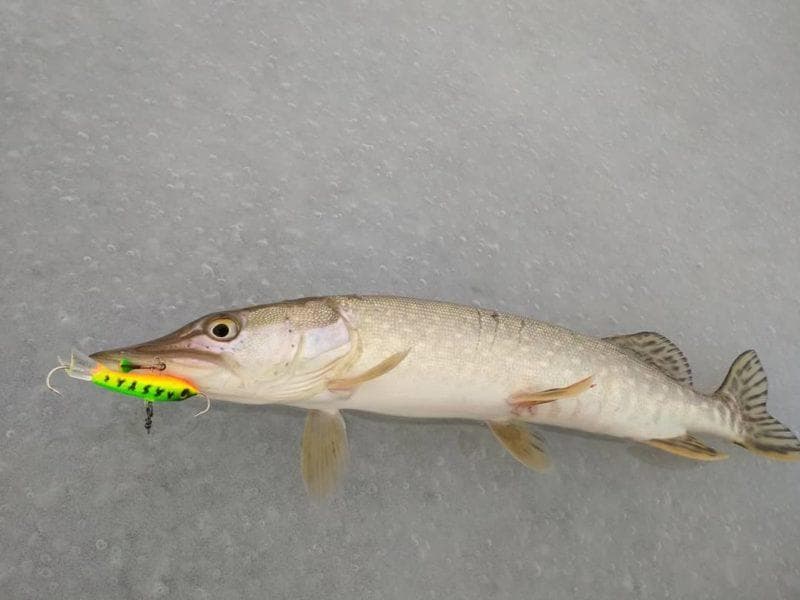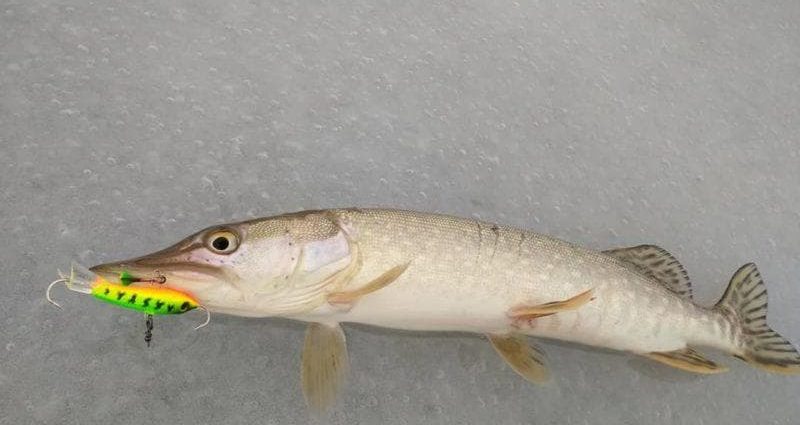Contents
Catching pike on a balancer in winter is one of the most interesting and effective ways to catch a toothy predator. Compared to fishing on vents (bets), such fishing is more sporty – the angler moves around the pond all the time, drills a large number of holes, changes lures, and uses various methods of posting.
What is a balancer
The balancer is an artificial bait used for winter fishing of predatory fish species.
Outwardly, it is a fairly realistic imitation of a small fish. Its main components are:
- lead run body;
- two single hooks soldered into the body in the head and tail;
- dorsal suspension – a small loop and used to fasten the leash clasp;
- movable tee on the abdominal suspension;
- plastic tail stabilizer
Some models do not have a plastic tail stabilizer. Instead, a small bright-colored twister or an edge of feathers, a red woolen thread, is put on the back single hook.
Tackle for winter pike fishing on a balancer
Pike fishing on a balancer is carried out using tackle consisting of:
- light and rigid carbon fiber winter rod 40-60 cm long with 4-5 access rings on the whip, comfortable cork handle and screw reel seat;
- inertialess reel size 1500-2000 with 3-4 bearings, front clutch and comfortable knob;
- 15-20 meter stock of strong monofilament fishing line with a section of 0,22-0,27 mm;
- 10-15 cm thin metal leash made of copper guitar string, tungsten or steel flexible cable.
Nodding is not used in gear used for pike on a balancer: the movement of a heavy and large bait during tossing, as well as the bites of even a small pike, are well transmitted through a thin fishing line and a carbon-fiber rod whip into the hand. Also, bites can often be seen by the bend of the thin and sensitive tip of the rod.
Choice of place and time of fishing
The success of catching pike on this bait, in addition to well-equipped tackle, is also determined by the right choice of place and time of fishing.
By first ice
On the first ice, pike are caught in the coastal zone with shallow depths (from 0,3-0,5 to 1,5-2,0 meters) and an abundance of vegetation that has not yet decomposed – reeds, reeds. Flooded bushes, trees lying at a shallow depth, large branches and twigs will also be very promising.
At this time, pike is well caught throughout the daylight hours.
In the dead of winter
In the middle of winter (January-beginning of February, and in Siberia – until mid-March), as ice builds up, pike gradually slides from shallow coastal areas to deeper ones. They catch it at this time on the edges of sharp dumps, in deep pits, channel ditches of reaches, in places where a stream, river, spring flows into a reservoir. These places are attractive for small fish and predators, since they do not have such a low content of vital oxygen.
In a large river, in addition to the main channel, pike are well caught at this time in the wintering pits of bays and oxbow lakes.

In small lakes and ponds, pike at this time goes to the deepest places with a more favorable oxygen regime.
The feeding activity of pike in the dead of winter is low – the predator hunts for only a few hours (in the morning or before dusk). The rest of the time, she stands at great depths and digests swallowed prey. On rainy days with gusty winds, heavy rainfall, severe frosts, and sudden changes in atmospheric pressure, the predator may stop hunting altogether.
On the last ice
At the end of the winter fishing season, the predator begins to prepare for spawning – although a short, but very catchy, pre-spawning zhor begins. At this time, the pike, following the flocks of small fish, leaves the pits, deep ditches, whirlpools and again rushes to the coastal zone. They catch it on the last ice at the confluence of streams, rivers, streams of melt water into the reservoir, in shallow areas with ice that has melted and begun to collapse, near gullies.
For special occasions, it is necessary to have in your pocket a long nylon cord with a sinker at one end and a loop at the other. Having fallen through the ice, the loop is put on the wrist of one of the hands, and the load with the cord is thrown to a nearby partner or a nearby fisherman. Also, good store or home-made lifeguards will not be superfluous at this time.
Bait selection
When choosing a balancer for pike fishing, take into account such characteristics of this bait as size, color.
To size
For catching medium and large pike, baits of this type are used from 7 to 12 cm long. When fishing in shallow waters, lead fish 5-6,5 cm long are used. Smaller baits 2,5-4 cm long are not used when catching even small pike – on they are very actively taken by annoying medium and small perch.
By color
On the first and last ice, pike are best caught on balancers painted in natural colors. In the dead of winter, the predator is better caught on baits of bright acid colors. If you plan to fish at dusk or on a cloudy day, then use lures with a fluorescent color. Such lead fish are also often used when catching zander in deep river pits and whirlpools.
Technique of fishing
Having figured out which balancer is better to use on a pike during a certain period of freezing, you can begin to study the technique of catching a toothy predator on this bait.
The simplest wiring of this bait is as follows:
- The bait is lowered into a hole drilled and slightly shaded by sludge.
- As soon as the bait has reached the bottom, it is raised above it by 3-5 cm.
- Sharply bending the arm at the wrist or elbow joint, perform a short swing – while the balance bar rushes up.
- After a wave, the bait is allowed to smoothly descend to the starting point. When descending, the balancer makes sweeping movements in the water column, thereby attracting a predator that is even at a great distance from the hole. The duration of this stage of posting is from 2-3 to 5-7 seconds.
- As soon as the bait has planned to the starting point, a new swing (toss) is performed.
Top 5 balancers for pike
The rating of the most popular balancers is headed by the following models:
- RAPALA JIGGING RAP W07;
- Nils Master Nisa 50;
- Scorana ICE FOX 55мм;
- KUUSAMO Balance 50mm;
- Lucky John Pro Series «Mebaru» 67 мм.
Useful Tips
- About which balancer to catch pike in winter on an unfamiliar reservoir, you can learn from local fishermen, who, with polite communication with them, will definitely share with colleagues some secrets in choosing the color and size of the balancer.
- The most popular Chinese online store aliexpress is the place where it is almost impossible to buy a good and working balancer. A large number of analogues of rapal and other branded lures sold there most often have poor workmanship, poor play. The only thing that Chinese baits win over the original ones is their lower price.
- A real review of a particular model of this bait can only be read on a specialized fishing forum.
- When searching for pike, they use not only an echo sounder, but also a special camera for underwater photography, which allows you to get a clear picture of everything that happens under water. In addition to video, this camera allows you to take very high-quality and clear photos.
- At first, small winter fishing rods with a built-in reel are used to fish for this bait. On them, a beginner can fill his own hand and train the skills of correct wiring in order to purchase more expensive and sensitive rods in the future.










